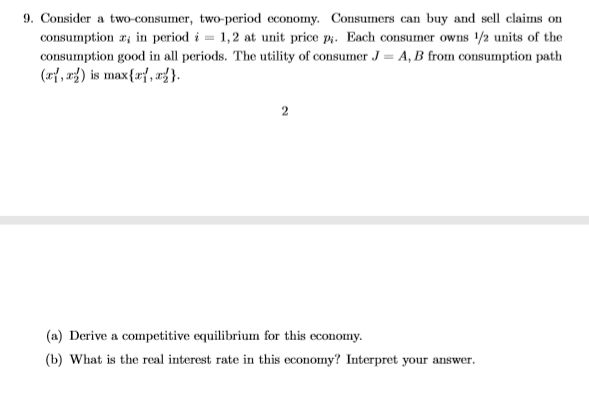
please help fix these questions. thanks
5. Consider a two-consumer economy in which wa = (0, 1), we = (1,0) and, for each J = A, B. the utility function of consumer J is x +3. if al > 23. (a) Illustrate this economy in an Edgeworth box. (b) Derive a competitive equilibrium for this economy. (c) Derive a competitive equilibrium for this economy which has different prices and allo- cations than the one you found in (b). 6. Consider an N-consumer, M-good economy in which each consumer J = 1,..., N has en- dowment w = (wi...,war) and utility function u'(r) over consumption bundles = (ar, ...,PM). Define a competitive equilibrium for this economy. 7. Consider a market for babysitting services. There are N adults, each of whom has 1 child and 1 bottle of whisky. Taking care of a child in this economy requires half of some adult's time every day, but an adult can hire other adults to babysit their own child. Similarly, an adult can hire himself out as a babysitter for other adults' children. When an adult is not taking care of a child, they are partying. Adults like both partying and drinking whisky, and they do not value taking care of children per se. (a) Define a competitive equilibrium for this economy. (b) Explain why partygoers are sober and babysitters are drunk in this economy. 8. Consider a two-consumer, two-period economy. Consumers can buy and sell claims on consumption , in period i = 1, 2 at unit price pi. There is 1 unit of the consumption good in period 1, which is entirely owned by consumer A. There is b > 0 units of the consumption good in period 2, which is entirely owned by consumer B. The utility of consumer J = A, B from consumption path (21, 27) is Ina/ + #lnay (a) Define a competitive equilibrium for this economy. (b) Derive a competitive equilibrium for this economy. (c) Suppose that 6 1. What is the real interest rate in this economy? Discuss why this differs from your answer in (c). 9. Consider a two-consumer, two-period economy. Consumers can buy and sell claims on consumption z, in period : = 1,2 at unit price p;. Each consumer owns 1/2 units of the consumption good in all periods. The utility of consumer J = A, B from consumption path (al, x4) is max (of, a!).1. We will finish the example from class. Consider a two-consumer economy in which w = (1, 1), WB = (1,2), u"(x, x4) = mix and uB(x5, 1?) = min(x8, 18]. Derive a competitive equilibrium for this economy. 2. Consider a two-consumer economy in which wa = (1, 1), we = (2,3), u"(of, z ) = x1 +x B BS and u (of,17) = $ 12 (a) Illustrate this economy in an Edgeworth box. (b) Define a competitive equilibrium for this economy. (c) Derive a competitive equilibrium for this economy. 3. Consider a two-consumer economy in which wa = (1, 2), w# = (2,2), u"(x1, 14) =21312 and u"(of, 17) = 1 12 (a) Illustrate this economy in an Edgeworth box. (b) Derive a competitive equilibrium for this economy. 4. Consider a two-consumer economy with two indivisible goods: both goods can only be purchased in whole (integer) units 1,2,3, .... Suppose that wa = (0, 1), w = (2,1), u(x1,12) = (x1) + vat and ub(x8,1!) = (x3) 3 + (25)1. (a) Illustrate this economy in an Edgeworth box. (b) Derive a competitive equilibrium for this economy in which (pi, p;) = (1, 1).9. Consider a two-consumer, two-period economy. Consumers can buy and sell claims on consumption z, in period ? = 1,2 at unit price p;. Each consumer owns 1/2 units of the consumption good in all periods. The utility of consumer J = A, B from consumption path (al, z!) is max(of, z). 2 (a) Derive a competitive equilibrium for this economy. (b) What is the real interest rate in this economy? Interpret your










